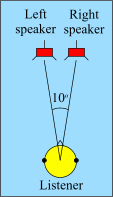|
| |
Stereo Dipole (1994-1996) 
|
 We use the term "stereo dipole" to describe a virtual source imaging system
that comprises two closely spaced loudspeakers. The two loudspeakers ideally span 10 degrees as seen by the listener, and so their centres are no more
than 15cm-30cm apart under normal listening conditions. They can therefore both be contained in the same cabinet.
We use the term "stereo dipole" to describe a virtual source imaging system
that comprises two closely spaced loudspeakers. The two loudspeakers ideally span 10 degrees as seen by the listener, and so their centres are no more
than 15cm-30cm apart under normal listening conditions. They can therefore both be contained in the same cabinet.
The stereo dipole creates a very
wide sound stage without introducing any noticeable colouration of the original signal. It generates a much simpler sound field than the conventional 60
degrees loudspeaker span, and it is therefore much more robust with respect to head movement. This page illustrates the profound difference between
the two systems by comparing the sound fields generated by the two loudspeaker arrangements. There are two graphics for each loudspeaker arrangement,
one for cross-talk cancellation, and one for virtual source imaging (the virtual source is at a position of 45 degrees to the left relative to straight
front as seen by the listener). In all four graphics, the two red spheres indicates the loudspeakers, and the circular area in the middle of the
yellow square indicates the listener's head which has been modelled as a rigid sphere. The "click" used as input to the virtual source, and as
reference signal for cross-talk cancellation, is a short pulse whose main energy is concentrated below 3kHz.
|
|
Crosstalk Cancellation
When the two loudspeakers span 60
degrees, the working principle of Atal and Schroeder's cross-talk canceller
is confirmed. As in the free-field case, the "zone of cross-talk cancellation"
is very small. When the loudspeaker span is reduced to 10 degrees, the
nature of the reproduced sound field is changed completely. It is no longer
possible to pick out any individual positive and negative pulses in the
sound field; instead only a single spherical wavefront is seen radiating
away from the two closely spaced loudspeakers. The pulse is now beamed
towards the listener's left ear, and a "line of cross-talk cancellation"
is directed towards the listener's right ear, and this has increased the
size of the zone of cross-talk cancellation significantly. The reproduced
sound field is very similar to that produced by a dipole source whose null
axis is rotated slightly anti-clockwise relative to the line that connects
the centre between the two loudspeakers with the centre of the listener's
head (it can be shown that the sound field reproduced by the stereo dipole
is almost exactly the same as the sound field reproduced by a monopole
and a dipole positioned at the centre between the two closely spaced loudspeakers).
Virtual Source Imaging
It is seen that the widely spaced
loudspeakers produce a very complex sound field whereas the two closely
spaced loudspeakers produce only two wavefronts. The first wavefront is
intended for the left ear, and the second wavefront, whose amplitude is
slightly smaller than the first, is intended for the right ear. The resulting
interaural time- and level differences are identical to those generated
by a real sound source at the position of the virtual image. |
|

